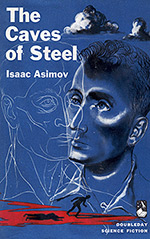
![]() JamesVirgil
JamesVirgil
3/12/2012
![]()
The Caves of Steel by Isaac Asimov. 205 pages. The book was first published as a serial in Galaxy Magazine, October to December 1953. A Doubleday hardcover followed in 1954.
The Caves of Steel is an interesting book in that it is a murder mystery set in the future. The tone of the book falls short of hard-boiled detective fiction. Asimov seems to be too genteel to me to deliver that kind of book. Instead he has written a detective novel where the mystery is solved by leaps of logic rather than the collection of hard evidence.
The Caves of Steel in the title refers to the great cities in which mankind reside in the future. Human beings have proliferated to eight billion people, and now are confined to complex cities underground. As a result, humans have developed agoraphobia and are afraid to leave the cities and venture into the open air. Humans have developed other interesting traits by living together in such close quarters in these hives, and Asimov explores these and uses them as plot points where possible. Contrasted with the dwellers of the Caves of Steel are those of Spacetown, who are from the fifty colonies of Earth. These denizens and the robots they bring with them are feared and barely tolerated. Relations between the colonists and the denizens of Earth are over-wrought as a result of prior riots and the different goals of these societies.
The main character, Lige Baley, is a plain clothes policeman who is forced to partner with a sophisticated robot, R. Daneel Olivaw to solve the murder of Olivaw’s designer. This puts Baley in a hard place as his family life and political forces involved in the murder bring complications to an already touchy situation.
The book does show some character development, but as usual with books of this time period, it is fairly slight, especially in regard to the female characters. As usual with a science fiction novel, the ideas are the highlight, and Asimov provides enough of these to make the book fun and enjoyable. He does explore some themes such as prejudice, over population, and the motivation of men. However, this book is probably enjoyed more if it just read at face value. I gave it a 7 out of 10.